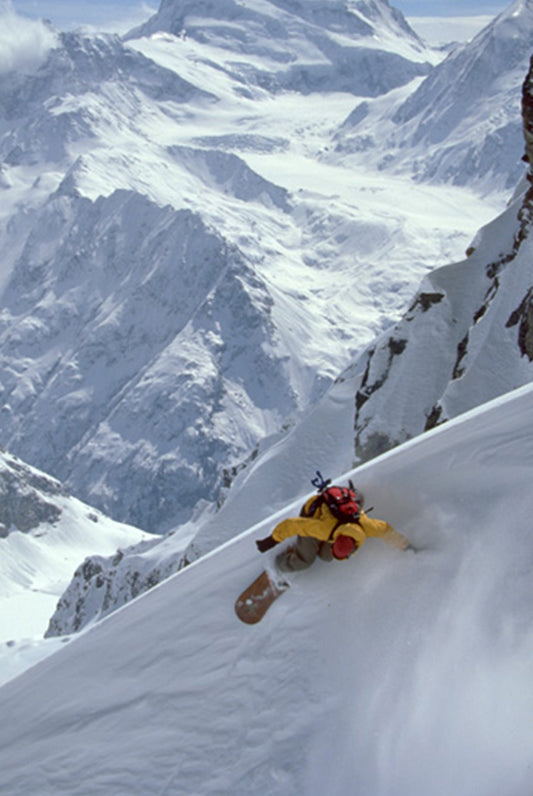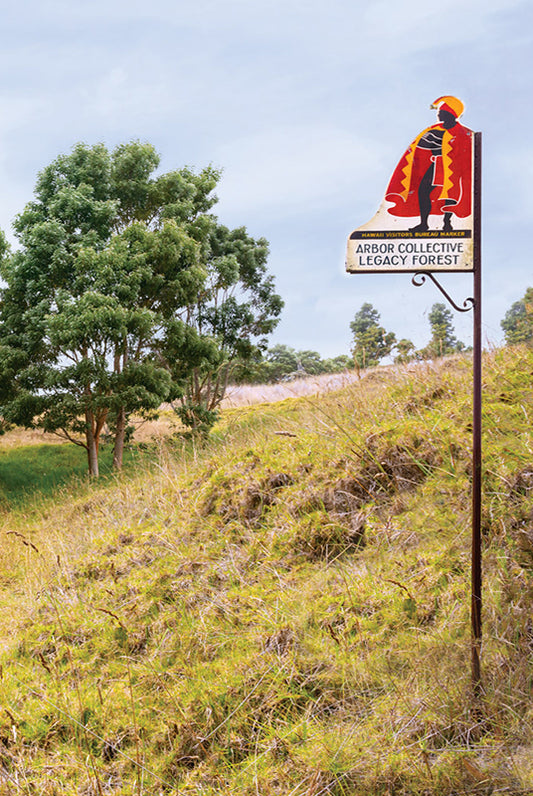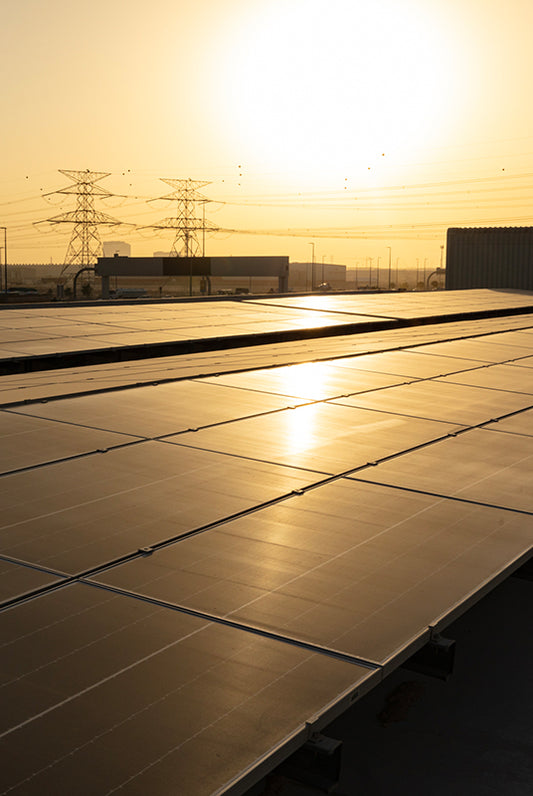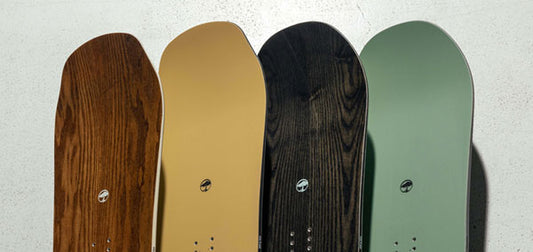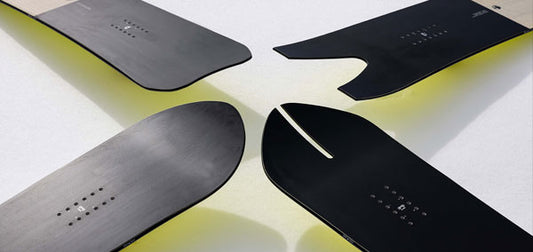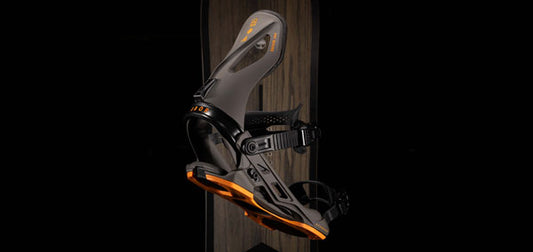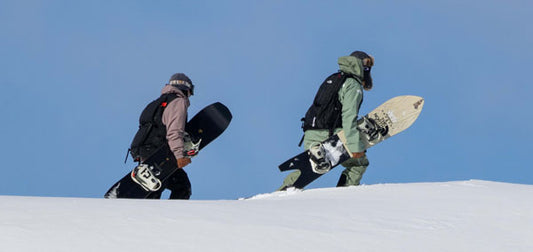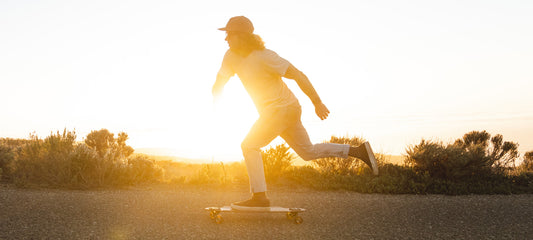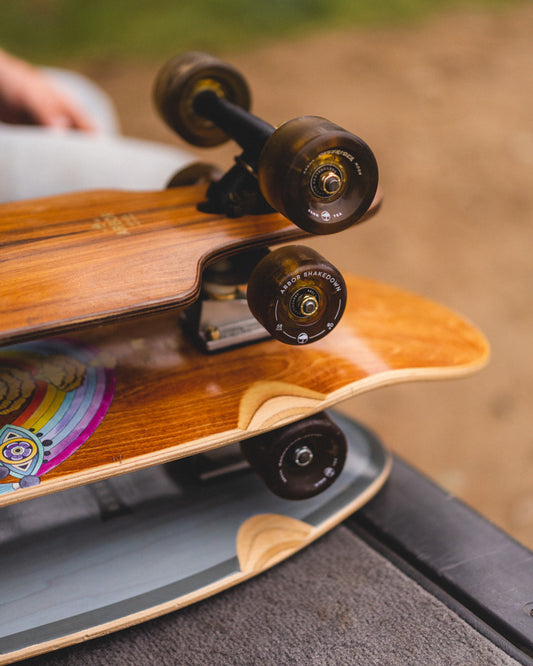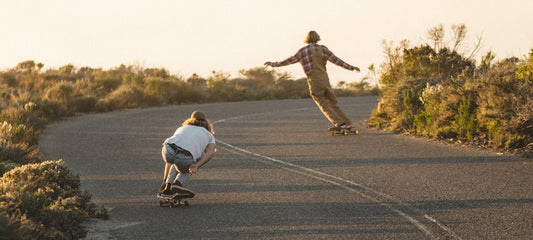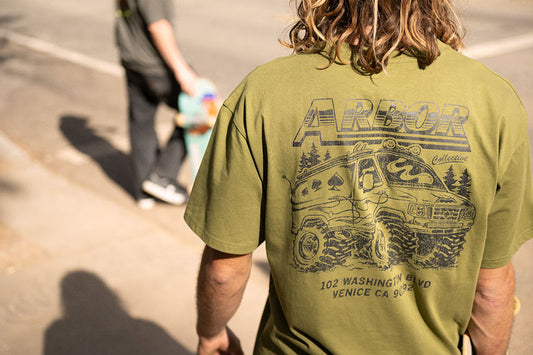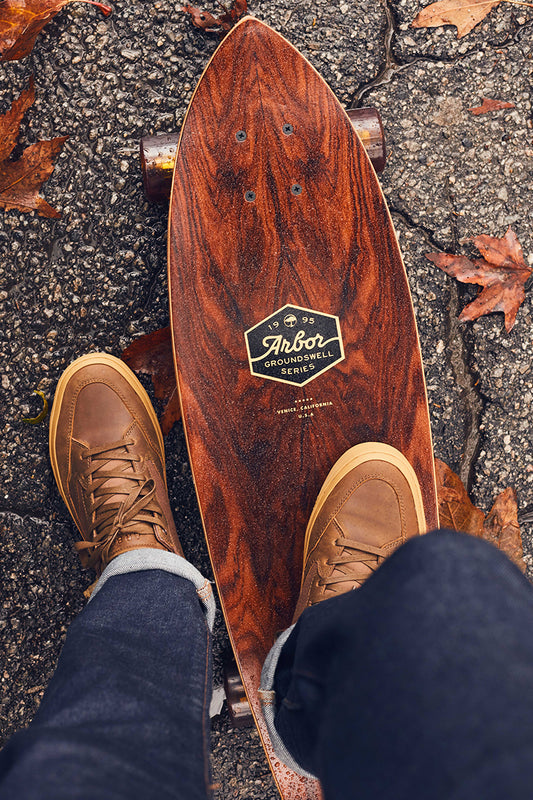All you need to learn about Trucks
Skateboard Trucks Guidebook
Skateboard Trucks
Trucks are the critical Component that connect your Skateboard to your Bearings and Wheels. More importantly, they help turn the board which controls the direction the rider is headed. Trucks were originally a part of rollerskates, which were modified to build the original Skateboards. They have seen many advancements over the years which have improved performance, durability, and the possibilities of what can be done on a Skateboard.
Baseplate
The Baseplate is the part of the Trucks that is attached to the Deck of a Skateboard. There are holes drilled into the Baseplate called Hole Patterns, which is where the Mounting Hardware mounts to the Trucks to the Deck. There is also a tunnel for the Kingpin and a Pivot Seat for the Pivot Cup. Most Baseplates are made with Aluminum to reduce weight, while adding strength and durability.
*Check out our Skateboard Deck Guidebook for more info on Old School and New School Hole Patterns.
Hanger
The triangular shaped component of the Trucks is called the Hanger, and is the largest component of the Trucks. The Hanger is the component that pivots from the Baseplate with the ground, and allows the rider to turn the Skateboard by leaning on the Deck from rail to rail. The Hole in the Hanger is where the Kingpin is mounted through, and the Pivot Arm is what connects the Hanger to the Pivot Seat via the Pivot Cup. Similar to Baseplates, most Hangers are made from Aluminum.
Axle
The Axle is the long metal rod threaded at both ends, which runs through the middle of Hanger. Axle Lock Nuts secure the Bearings and Wheels to the ends of Axles, and require a 1/2" Wrench to adjust. Materials used in Axles vary from Steel, Chromoly, to Titanium, and are either Solid or Hollow. Axle Widths should be similar to the Deck Width for best fit, varying by no more than 1/4" wider or narrower than the Width of the Deck.
Speed Rings
Speed Rings are used as Spacers mounted on the Axles, sitting outside of the Bearings between the Axle Nuts and Hanger. They reduce the friction caused by the faces of the Bearings rubbing against the Hanger and Axle Nuts, and increase the overall roll speed of the Bearings. Some Skateboard Trucks have Speed Rings integrated with the Hanger and Axle Nuts, eliminating extra parts.
Kingpin
The Kingpin is a threaded bolt that attaches the Baseplate to the Hanger. The Kingpin runs through the Hole in the Baseplate and Hanger, and is attached by a Kingpin Lock Nut which uses a 9/16" Wrench to tighten. However, there are different Kingpin designs that are backwards, depending on the Brand and Model of Trucks. Kingpins are generally made form Steel or Chromoly and can be either Solid or Hollow. The tightness of the Kingpin affects ease turning, and is based on the preference of the rider. The angle of the Kingpin also affects the turning radius of the Trucks. Steeper Kingpin Angles are usually more stable, with slacker Kingpin Angles usually being more maneuverable.
Bushings
Bushings are mounted on the Kingpin, sandwiching the Hanger, which act as dampeners for the Trucks. Shapes of Bushings can vary from Barrels to Cones, depending on the preference of the rider and the level of performance needed. Bushings are generally made from Urethane and can vary in hardness, known as the Durometer. The Bushing Durometer can also affect the performance and feel of the Trucks. Some Bushings feature mixed materials or Dual-Durometers, which offer additional performance aspects.
Bushing Washers
Bushing Washers sit outside the Bushings, and act as a buffer between the Baseplate and Kingpin Nut. They hold the Bushings in place by evenly distributing pressure, and can also eliminate any movement or additional flex of the Bushing, depending on the size, shape, and orientation of the Bushing Washers.
- Flat: Simply, a flat Washer.
- Cup: Washer with a radial edge creating a cup-like shape.
- Reverse Cup: Cup Washer flipped upside down to simulate a Flat Washer.
Pivot Cup
Pivot Cups sit in the Pivot Seats of the Baseplate. They act as a buffer between the Hanger and Baseplate and are usually made from Urethane or Plastic. Different Durometers of materials are used, depending on the rider's preference and performance needed.
Kingpin Types
There are various types of Kingpins based on the placement and angle of the Kingpin. They affect the way the Skateboard turns, by altering the Turning Radius of the Trucks.
Standard Kingpin
Most Skateboards with a standard to narrow wheelbase utilize Standard Kingpin Trucks. The Kingpins are between the Hangers towards the middle of the when mounted to the Skateboard. Standard Kingpin Trucks are found on most Popsicles and Cruisers, and are generally easier to turn.
Reverse Kingpin
Skateboards with longer Wheelbases are generally more difficult to turn. Reverse Kingpin (RKP) Trucks, were created to increase the Turning Radius on Skateboards with longer Wheelbases, but RKP Trucks can also be used on boards with smaller Wheelbases. The Kingpins are on the outside of the Hangers towards the Nose and Tail when mounted ot the Skateboard. Most Longboards feature Reverse Kingpin Trucks, which are more stable.
Double Kingpin
Double Kingpin Trucks were created with an extra Kingpin to expand the Turning Radius even further than Standard and RKP Trucks. Companies like Carver, pioneered new types of Trucks, expanding the possibilities with a new style of Skateboard called a Surfskate. Arbor is proud to partner with Carver Trucks on our Shaper Series Skateboards.
Truck Measurements
It's important to understand the different Measurements of Skateboard Trucks, to allow for the best fit for your Skateboard, and preferred riding style.
Hanger Width
Most Trucks are described by their inner width, which is known as the Hanger Width. This can be confusing for some, so it's generally better to reference Axle Width when comparing Trucks and choosing the right size Truck for a Skateboard.
Axle Width
Axle Widthis the measurement of the widest points of the Axle. It's best practice to match the width of the Axle to the width of the Skateboard, give or take 1/4" wider or narrower than the width of the board. If the Axles are too wide or narrow, it will dramatically will affect stability.
Truck Height
Most Trucks are described as Low, Mid, or High, which refers to the overall height of the Truck,measuring from the Baseplate Bottom to the Top of the Hanger.
- Low Trucks: Generally more stable and lighter, but are more likely to cause Wheelbite, which is when your Wheels abruptly hit the Bottom of the Deck of the Skateboard and stop or reduce momentum dramatically. Riding smaller Wheels, tightening your Kingpins, or adding Shock or Riser Pads are recommended on Low Trucks to avoid Wheel Bite.
- Mid Trucks: The best of both worlds between Low and High Trucks; a balance of stability and pop performance as well as balancing weight overall.
- High Trucks: Higher Trucks move the rider higher off the ground, which provides more leverage, potentially allowing for more pop. However, they are less stable and generally heavier than Low or Mid Trucks. Higher Trucks allow for much larger Wheels to be used, especially when using Shock or Riser Pads.
*Check out our other Guidebooks for more info on Decks, Wheels, Riser Pads, and Components.


